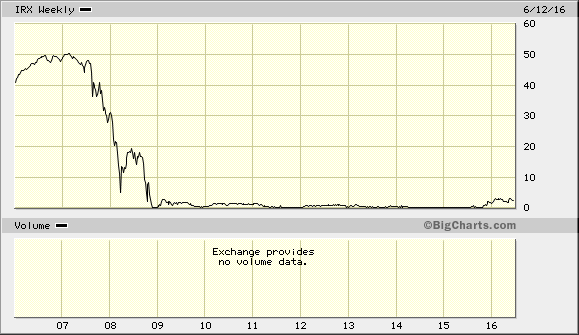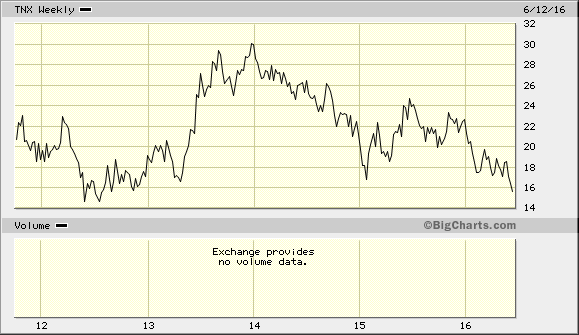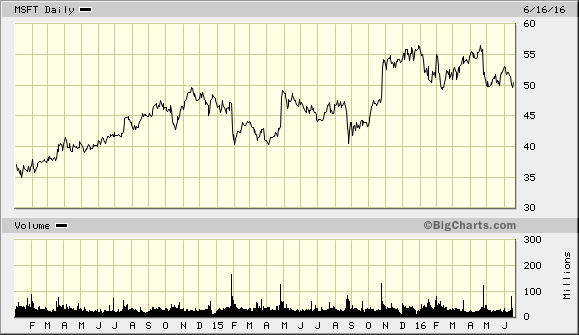CWS Market Review – June 17, 2016
“He that can have patience can have what he will.” – Benjamin Franklin
At the end of this month, the U.S. economic recovery will turn seven years old. (They grow up so fast!) Almost constantly for seven years, we’ve heard folks wonder, “When will interest rates finally return to normal?”
Yet every single prediction for higher rates has been wrong. All of them—and there have been many. At some point, you have to draw the line and say that seven years is long enough. What we have now is normal. It’s the new normal.
This week, the Federal Reserve once again decided against raising interest rates. That was hardly a surprise. There’s now a reasonable chance the central bank may go all year without touching interest rates. We’ve seen a big disconnect between what the Fed’s been saying and what the Fed’s been doing. Hawkish talk and dovish walk.
In this week’s CWS Market Review, we’ll take a closer look at the Fed’s plans for 2016 and what they mean for investors. We also had some exciting news for our Buy List. Microsoft announced that it’s buying LinkedIn for $26.2 billion. We also have an upcoming earnings report from Bed Bath & Beyond. The home-furnishings stock has been beaten up, and I think it’s a good value here. But first, let’s look at what the Fed didn’t do and why they didn’t do it.
Welcome to the New Normal
If you look at the Fed’s projections from three years ago, they predicted that interest rates would be a lot higher by 2016. Yet here we are, and interest rates are still just above 0%. As low as they are here, rates are even lower in Europe. The 10-year bond in Germany is negative. This week, the Swiss Central Bank decided to leave rates unchanged at, hold on, -0.75%! Germany has negative interest rates out to ten years. Japan’s are negative out to 15 years and Switzerland’s are out to 30 years!
The Federal Reserve met on Tuesday and Wednesday of this week. On Wednesday afternoon, they released their latest policy statement which said they’re keeping interest rates unchanged. Earlier this year, Janet Yellen and other Fed members expressed their belief that rates need to go higher at some point. They’ve always left wiggle room, saying that they’re going to be “data dependent” and such. But whenever the time has come to strike, the Fed has always seemed to pass. They’ve only hiked once, and that was in December.
Two weeks ago, we got the May jobs report, and it was a bust. That convinced me, and a lot of folks besides, that the Fed wasn’t about to raise rates. The good news for the economy is that the unemployment rate is down, but there are still large gaps. Wage growth, for example, has been pretty weak. Business investment isn’t terribly strong. The economy probably did better in Q2 than it did during Q1, but it’s hard to make an argument that the economy is overheating.
Just look at inflation. This week, we got the latest CPI, and it showed that inflation is still well contained. Consumer prices rose by just 0.2% last month, which was below what economists had forecasted. The core rate, which ignores food and energy prices, also rose by 0.2%. Inflation is hardly a problem.
Now comes the interesting part. In addition to the Fed’s policy statement, the Fed members also updated their economic projections. I should add that the Fed has a pretty lousy track record, but it’s interesting to see what they’re thinking.
There are 17 members who provide forecasts. Of them, six see the Fed raising interests just once this year, while nine members see two rate hikes. Not that long ago, the Fed was expecting four rate hikes this year, plus another four next year. How times have changed. With every meeting, it seems, the Fed gradually cedes more ground to reality. As I said, hawkish talk and dovish walk.
What struck me is that the Fed sees the real Fed Funds rate, meaning adjusting for inflation, as being negative through 2017. That means real rates are expected to be negative for another 18 months. At least!
The 10-Year Treasury Yield Plunges
The bond market responded by going absolutely bonkers. The yield on the 10-year Treasury got as low at 1.52%. That’s astounding. Think of what the market is saying here. You can loan your money to Uncle Same for a decade, and in that time, you’ll make a total return of 15%. That’s pathetic.
The 10-year bond yield reached its multi-decade low four years ago when it touched 1.39%. At the time, I wondered if that marked the end of a 30-year bull market for bonds. By late 2013, the yield soared all the way up to crazy, insane, nosebleed levels. By that, I mean 3%. (Three whole percent!)
Here’s an interesting tidbit: The 10-year yield touched its generational low the same day Mario Draghi made his famous proclamation that he’ll do whatever it takes to preserve the euro—“believe me, it will be enough.” Four years later, there’s a couple trillion dollars’ worth of negative-yielding bonds floating around, and Draghi is now buying corporate bonds.
Let’s break down some math. The 10-year TIPs (inflation-protected bonds) yield a minuscule 0.15%. The regular 10-year yield closed Thursday at 1.564%. Compare that to the S&P 500, which has an indicated dividend yield of 2.18%, and that’s for the whole index. Remember that 85 stocks (or 17%) in the S&P 500 don’t even pay a dividend. Yet the financial markets are offering 60 basis points extra to take on stocks compared with bonds, and that ignores the big fact that stocks can raise their dividends. It’s right there in the name; fixed income is fixed.
The bottom line is that the market is asking you—begging you—to ignore bonds and lock in blue-chip stocks for the long term. There’s simply nowhere else to go.
I want to reiterate another point I’ve made a few times, that the market has shifted toward cyclical stocks. That means stocks like Transports, Industrial, Chemicals and Energy. Unfortunately, our Buy List is underweighted in those sectors, so we haven’t ridden the recent rally as much as I would have liked.
For the time being, we should expect interest rates to stay near 0%. This is the new normal. I’m not expecting things to go back to where they were. The larger question, and one that I’m not equipped to answer, is, “Have we reached the limit of what monetary policy can do for the economy?” The Fed is powerful, but there are things even beyond their control. Perhaps the U.S. economy needs deep structural changes that can be addressed with free money. Until then, we should need Mr. Franklin’s advice and be patient.
Microsoft Buys LinkedIn for $26.2 Billion
Microsoft (MSFT) shocked us this week by announcing that it’s buying LinkedIn (LNKD), the resume folks, for $26.2 billion. That works out to $196 per share for LNKD, which is a 50% premium. That sounds like a lot, but it’s still well below LinkedIn’s peak price of $276 per share.
This is a bold move for Microsoft. It’s their largest deal ever. The software giant actually had the chance to buy LinkedIn more than 10 years ago for $250 million. Critics point out that this is an expensive buy, and I have to agree, but I’m leaning towards liking this deal. Microsoft has been rightly criticized for a string of lousy deals, but those were done by Steve Ballmer, the former CEO. Satya Nadella, the current CEO, seems to have a more cautious approach.
The deal will have almost no impact on Microsoft’s earnings this year or next. After that, it should start giving a boost to MSFT’s bottom line. Microsoft said they intend to finance the deal with debt. Moody’s said that they’re going to review Microsoft’s AAA-rating. My response: Who cares if they lose their AAA rating? They’re sitting on $117 billion in cash and liquid assets (much of that is outside the U.S.)
This ties in to what I said earlier about bonds. I imagine there are lots of European investors who are getting nothing on their bonds that would love to load up on some newly minted Microsoft bonds. Mr. Nadella can do them the favor of borrowing their money on the cheap. Microsoft still has its gigantic $40 billion share-repurchase authorization that it’s planning to wrap up by the end of this year. In other words, Microsoft has no problems with cash flow.
Shares of Microsoft dropped to $49 after the deal was announced, but have since rallied back to $50.39. I’m going to give Nadella the benefit of the doubt here. Look for a good earnings report from Microsoft on July 19. The shares currently yield 2.86%.
Bed Bath & Beyond Earnings Preview
We’re in one of the quiet stretches for our Buy List earnings reports. There’s only one earnings report due for the month of June: Bed Bath & Beyond (BBBY). The company is scheduled to report its fiscal Q1 earnings on Wednesday, June 22.
Shares of BBBY have been very unpopular lately, and I think the selling is overdone. The last earnings report wasn’t so bad. Earnings came in near the top of expectations. Same-store sales adjusted for currency grew by 2.1%. That’s not bad at all.
A big problem for Bed Bath is that their margins are getting squeezed. That’s a tough headwind for any business. The company made $5.10 per share last year. They said they expect earnings to be near the high end of their range of $4.50 to $5 per share. That means the stock is going for less than 10 times this year’s earnings.
Wall Street expects Q1 earnings of 86 cents per share which is down from the 93 cents per share they made in last year’s Q1. Bed Bath also recently initiated a quarterly dividend of 12.5 cents per share. They also love to buy back enormous amounts of their own stock.
For all the talk of Bed Bath being stuffy and insular (which is fair), they struck back this week by announcing the purchase of One Kings Lane, an online retailer. One Kings Lane had been valued at nearly $1 billion. For a time, it was one of the hottest businesses around. They raised a ton of VC money, but weren’t able to get into the big leagues. Now Bed Bath has stepped in with an undisclosed offer. By all measures, BBBY is a cheap stock.
That’s all for now. We’re nearing the end of the first half of 2016. Next week, we’ll get reports on new and existing home sales, plus orders for durable goods. But the big event for world finance will be the Brexit vote on June 23 when Britain decides if it wants to remain in the EU. Polls show that it’s very close. Be sure to keep checking the blog for daily updates. I’ll have more market analysis for you in the next issue of CWS Market Review!
– Eddy
Posted by Eddy Elfenbein on June 17th, 2016 at 7:08 am
The information in this blog post represents my own opinions and does not contain a recommendation for any particular security or investment. I or my affiliates may hold positions or other interests in securities mentioned in the Blog, please see my Disclaimer page for my full disclaimer.
- Tweets by @EddyElfenbein
-
-
Archives
- April 2024
- March 2024
- February 2024
- January 2024
- December 2023
- November 2023
- October 2023
- September 2023
- August 2023
- July 2023
- June 2023
- May 2023
- April 2023
- March 2023
- February 2023
- January 2023
- December 2022
- November 2022
- October 2022
- September 2022
- August 2022
- July 2022
- June 2022
- May 2022
- April 2022
- March 2022
- February 2022
- January 2022
- December 2021
- November 2021
- October 2021
- September 2021
- August 2021
- July 2021
- June 2021
- May 2021
- April 2021
- March 2021
- February 2021
- January 2021
- December 2020
- November 2020
- October 2020
- September 2020
- August 2020
- July 2020
- June 2020
- May 2020
- April 2020
- March 2020
- February 2020
- January 2020
- December 2019
- November 2019
- October 2019
- September 2019
- August 2019
- July 2019
- June 2019
- May 2019
- April 2019
- March 2019
- February 2019
- January 2019
- December 2018
- November 2018
- October 2018
- September 2018
- August 2018
- July 2018
- June 2018
- May 2018
- April 2018
- March 2018
- February 2018
- January 2018
- December 2017
- November 2017
- October 2017
- September 2017
- August 2017
- July 2017
- June 2017
- May 2017
- April 2017
- March 2017
- February 2017
- January 2017
- December 2016
- November 2016
- October 2016
- September 2016
- August 2016
- July 2016
- June 2016
- May 2016
- April 2016
- March 2016
- February 2016
- January 2016
- December 2015
- November 2015
- October 2015
- September 2015
- August 2015
- July 2015
- June 2015
- May 2015
- April 2015
- March 2015
- February 2015
- January 2015
- December 2014
- November 2014
- October 2014
- September 2014
- August 2014
- July 2014
- June 2014
- May 2014
- April 2014
- March 2014
- February 2014
- January 2014
- December 2013
- November 2013
- October 2013
- September 2013
- August 2013
- July 2013
- June 2013
- May 2013
- April 2013
- March 2013
- February 2013
- January 2013
- December 2012
- November 2012
- October 2012
- September 2012
- August 2012
- July 2012
- June 2012
- May 2012
- April 2012
- March 2012
- February 2012
- January 2012
- December 2011
- November 2011
- October 2011
- September 2011
- August 2011
- July 2011
- June 2011
- May 2011
- April 2011
- March 2011
- February 2011
- January 2011
- December 2010
- November 2010
- October 2010
- September 2010
- August 2010
- July 2010
- June 2010
- May 2010
- April 2010
- March 2010
- February 2010
- January 2010
- December 2009
- November 2009
- October 2009
- September 2009
- August 2009
- July 2009
- June 2009
- May 2009
- April 2009
- March 2009
- February 2009
- January 2009
- December 2008
- November 2008
- October 2008
- September 2008
- August 2008
- July 2008
- June 2008
- May 2008
- April 2008
- March 2008
- February 2008
- January 2008
- December 2007
- November 2007
- October 2007
- September 2007
- August 2007
- July 2007
- June 2007
- May 2007
- April 2007
- March 2007
- February 2007
- January 2007
- December 2006
- November 2006
- October 2006
- September 2006
- August 2006
- July 2006
- June 2006
- May 2006
- April 2006
- March 2006
- February 2006
- January 2006
- December 2005
- November 2005
- October 2005
- September 2005
- August 2005
- July 2005



 Eddy Elfenbein is a Washington, DC-based speaker, portfolio manager and editor of the blog Crossing Wall Street. His
Eddy Elfenbein is a Washington, DC-based speaker, portfolio manager and editor of the blog Crossing Wall Street. His